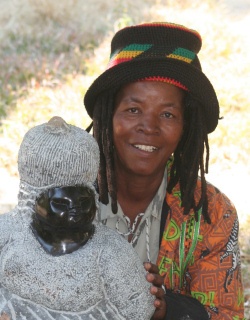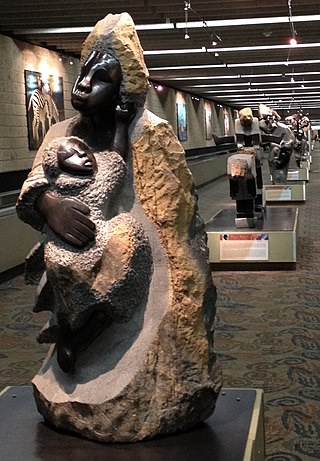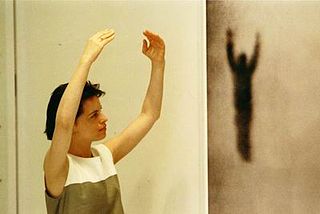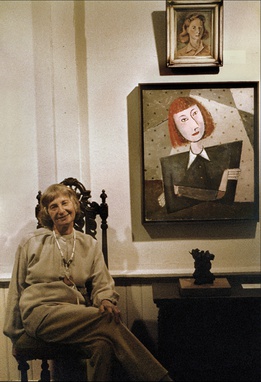Related Research Articles
Vija Celmins is a Latvian American visual artist best known for photo-realistic paintings and drawings of natural environments and phenomena such as the ocean, spider webs, star fields, and rocks. Her earlier work included pop sculptures and monochromatic representational paintings. Based in New York City, she has been the subject of over forty solo exhibitions since 1965, and major retrospectives at the Museum of Modern Art, Whitney Museum of American Art, Los Angeles County Museum of Art, San Francisco Museum of Modern Art, Institute of Contemporary Arts, London and the Centre Pompidou, Paris.

Yvonne Vera was an author from Zimbabwe. Her first published book was a collection of short stories, Why Don't You Carve Other Animals (1992), which was followed by five novels: Nehanda (1993), Without a Name (1994), Under the Tongue (1996), Butterfly Burning (1998), and The Stone Virgins (2002). Her novels are known for their poetic prose, difficult subject-matter, and their strong women characters, and are firmly rooted in Zimbabwe's difficult past. For these reasons, she has been widely studied and appreciated by those studying postcolonial African literature.

Eva Hesse was a German-born American sculptor known for her pioneering work in materials such as latex, fiberglass, and plastics. She is one of the artists who ushered in the postminimal art movement in the 1960s.

Hannah Wilke was an American painter, sculptor, photographer, video artist and performance artist. Wilke's work is known for exploring issues of feminism, sexuality and femininity.
Nicholas Mukomberanwa was a Zimbabwean sculptor and art teacher. He was among the most famous protégés of the Workshop School at the National Gallery of Zimbabwe. He was a mentor to the Mukomberanwa Family of sculptors. Mukomberanwa married his first wife, sculptor Grace, in 1965 and they had eight children. In 1965, he decided to end his career with the police to become a sculptor full-time. He continued to hone his skills over the following decade, developing one of the most distinctive personal styles found in his generation of Zimbabwean stone sculptors. The gambit paid off, and by the late 1970s and in the 1980s his work was being shown in many venues. His work has been exhibited in galleries around the world. He also became mentor to many artists in Zimbabwe, including his children Anderson Mukomberanwa, Ennica Mukomberanwa, Lawrence Mukomberanwa, Netsai Mukomberanwa, Taguma Mukomberanwa,Tendai Mukomberanwa and nephew, Nesbert Mukomberanwa who are also sculptors. He remains one of Zimbabwe's most famous artists.
Ennica Mukomberanwa is a Zimbabwean sculptor. The daughter of Grace Mukomberanwa and Nicholas Mukomberanwa, she was trained by the first generation of sculptures. Her work is exhibited in private collections and at galleries around the world. She is a third generation Zimbabwean sculptor. In 2004, she was awarded a prize which allowed her to travel to Stockholm, Copenhagen, Scotland, and Canada. She is a member of the Mukomberanwa family of sculptors. She is the daughter of Grace Mukomberanwa and Nicholas Mukomberanwa, who served as her mentor. She is the sister of sculptors Anderson, Netsai, Taguma, Tendai Mukomberanwa and Lawrence Mukomberanwa, and the cousin of Nesbert Mukomberanwa.

Joram Mariga has been called the “Father of Zimbabwean Sculpture” because of his influence on the local artistic community starting in the 1950s and continuing until his death in 2000. The sculptural movement of which he was part is usually referred to as “Shona sculpture”, although some of its recognised members are not ethnically Shona.

Colleen Madamombe was a Zimbabwean sculptor working primarily in stone. Her work expresses themes of womanhood, motherhood, and tribal Matriarchy.
Fanizani Akuda, also known as Fanizani Phiri, was a member of the sculptural movement usually called "Shona sculpture", although he and some others of its recognised members were not ethnically Shona. He worked initially at the Tengenenge Sculpture Community, 150 km north of Harare near Guruve, which he joined in 1966.

Dame Vera Doreen Blumhardt was a New Zealand potter, ceramicist and arts educator.

Sculpture and in particular stone sculpture is an art for which Zimbabwe is well known around the world.
Celia Winter-Irving, was an Australian-born, Zimbabwean-based artist and art critic who wrote extensively on Zimbabwean art, especially Shona sculpture, when she lived in Harare from 1987 to 2008.
Doreen Southwood is a South African artist, designer, and boutique owner based in Cape Town. She works in a wide variety of media in her artwork, producing sculptures, objects, prints, film, and more, which she often bases on personal experiences and self exploration. Her candidness regarding personal flaws and the cycles of repression and coping that accompany conservative, middle class, Afrikaans upbringing inform much of her work, calling attention to ways in which women are silenced or otherwise repressed in that space.

Michal Rovner, also known as Michal Rovner Hammer, is an Israeli contemporary artist, she is known for her video, photo, and cinema artwork. Rovner is internationally known with exhibitions at major museums, including the Louvre (2011) and the Whitney Museum of American Art (2002).
Maryon Kantaroff was a Canadian sculptor known for her large-scale outdoor sculptures in bronze and other materials.
Thenjiwe Lesabe was a Zimbabwean nationalist who was also a teacher, war veteran and political activist.
Angela Godfrey is an English sculptor and Member of the Royal Society of Sculptors.

Sharyn Egan is a Nyoongar artist known for her work in painting, sculpture, weaving and walking. Based in Fremantle, Western Australia, Egan's works are held in the collections of the National Museum of Australia and the Berndt Museum of Anthropology, and she has created artworks for the Perth International Arts Festival.

Amalie Rothschild (1916–2001) was an American artist who lived and worked within the art community of Baltimore, Maryland. An accomplished painter and sculptor, she was also an art teacher, philanthropist, patron, and cultural advocate. Over the course of a long career, she made oil and acrylic paintings as well as drawings, watercolors, and other paper works. She also sculpted using found objects, Plexiglas, metals, and particleboard. Originally working in a realist style, she became well known for geometric abstractions based on figurative subjects. In 1993 a critic described this approach as "[walking] a tightrope between the abstract and the representational with a suggestion of three-dimensional depth." Rothschild was by choice a regional artist. Although she occasionally exhibited elsewhere, she did not actively promote her career outside a mid-Atlantic region centered on Baltimore. Thus, in 1997 a critic wrote, "Amalie Rothschild is a fixture and ornament of the Baltimore art world." At the time of her death a critic gave this career summary: "She was one of the leading artists of her time in this area. Her work is thoroughly modern and related to geometric abstraction, but without losing the figure. It has emotional reserve, often contains a hint of humor and at times recalls the childlike sagacity of the great Paul Klee."
Helen Lieros was a Zimbabwean visual artist. She was born in Gweru, Zimbabwe to Greek parents. She studied at the Ecole des Beaux-Arts and the Centre Contemporaine de la Gravure in Geneva, Switzerland. She also spent time at the Istituto statale d'arte di Firenzein Florence, Italy. After wandering in Europe, Lieros returned to Zimbabwe in 1964 and took up a position as a teacher at Chaplin High School, where she had been a student. She moved to Harare in 1967, where she lived until her death on 14 July 2021.
References
- ↑ "Doreen Sibanda: Life imitating art". The Herald. Retrieved 2018-03-08.
- ↑ "About Doreen Sibanda - Pindula, Local Knowledge". www.pindula.co.zw. Retrieved 2018-03-08.
- ↑ "National Gallery of Zimbabwe historical background" . Retrieved 2018-03-08.
- ↑ Zimbabwe stone sculpture : a retrospective, 1957-2004. Sibanda, Doreen, 1954-. Harare: Embassy of France, with Weaver Press. 2004. ISBN 9781779220301. OCLC 61219317.
{{cite book}}: CS1 maint: others (link)